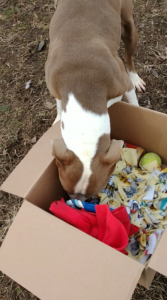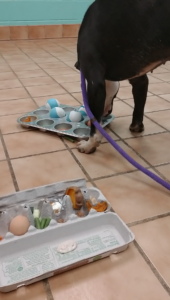Barks Blog
Phoenix Blog Competition: Working to Address Stress
By Jerri Colonna

I am a shelter volunteer on the behavior and enrichment team at Indianapolis Animal Care Services (IACS) and we have worked very hard as volunteers to develop some great enrichment for our dogs. We are a very large inner city, open intake shelter and many of our dogs only get to go outdoors once every 24 hours, so it can be a stressful environment for them – especially if they are there long-term. Because of this, we have an enrichment group that focuses on things we can do, as volunteers, to improve the quality of life for our dogs while they await their forever home. One of the enrichment ideas I have worked on and promoted is the “enrichment box.” An enrichment box can be as simple as to include things found at the shelter, or more elaborate to include a selection of healthy and interesting items.
To create an enrichment box, it all starts with a cardboard box (or an egg carton). Ideally, the box will be one that is shallow and wide with flaps that can be partially open or closed depending on the interest level of the dog. It can also include several boxes within a box.
Things that are very commonly found at the shelter that we can toss in the box include: tennis balls (two usually), Kong filled with peanut butter, frisbee, squeaky toy, empty toilet paper/paper towel roll with hot dogs or chicken inside, rope toy, snuffle mat containing dog food, and Nylabone and treats rolled up in packing paper. This is usually the most basic kind of enrichment box and can be thrown together very spontaneously with little effort (see videos below).
Items that I have included for more elaborate enrichment boxes that need to be prepared in advance can include: cut up veggies/fruit (carrots, green beans, cucumber, apple, blueberries), yogurt, cooked sweet potato, canned pumpkin puree, hardboiled egg (including shell), canned tuna/salmon, cat food, and cream cheese/cheese spray smeared inside. Very small amounts of these can all be added to a muffin pan, tennis balls placed on top and then everything placed inside the box. I recommend being conservative with the items to prevent the possibility of an upset stomach.
The dogs thoroughly enjoy investigating these boxes and can spend 20-30 minutes going back to them and interacting with the toys/edibles inside. The activity is supervised so nonfood items are not accidentally ingested. The boxes are great for stimulating the dogs’ sense of smell since they have such a variety of different items and it is especially interesting to watch dogs who may have never had an opportunity to play with toys working on their boxes (see videos below).

Mental Workout
At the shelter, we have some fenced outdoor play yards where we are able to interact with the dogs when they are working on their boxes (and clean up the mess that is almost always made). This means we can also alleviate any guarding issues that may present. When it’s cold outside, we have also given the boxes to the dogs in some of the meet and greet areas, but we avoid placing them inside the individual kennels due to possibility of ingesting a foreign object or resource guarding.
The enrichment boxes are a really effective way of providing a stimulating enrichment for dogs at the shelter who, in this case, are confined to a small kennel for around 23 hours a day. It is also a great way to interact one-on-one with the dogs given that providing a leash walk to every dog, every day is just not a possibility. In addition, it is amazing to see a less confident or shutdown dog start to develop confidence and more of their personality emerge.
Enrichment at our shelter has become much more diverse these days and we are always trying to implement creative new ideas. We have an amazing group of staff and volunteers who work incredibly hard for the homeless animals in our community.
*This post is an entry in our Phoenix 2020 Writers’ Competition. All winning, runner up and selected entries are being published here on the BARKS Blog and in upcoming issues of BARKS from the Guild. For a fully immersive educational experience in animal sheltering and rescue, join us at the Pet Professional Guild Annual Summit in Phoenix, Arizona on September 17-21, 2021.*
About the Author
Jerri Colonna is a shelter volunteer at Indianapolis Animal Care Services who works on the behavior and enrichment team. She first learned about “enrichment boxes” on the Canine Enrichment Facebook group a couple years ago and has since modified the concept to adapt it to items that can be found at the shelter. She has also created and posted “how to” videos in her online shelter group so any volunteer or staff interested in making one can do so and then offer it to a dog. She has recently become a member of PPG to start the process of getting her own dog training business started. Previously, she has completed a dog training academy and has logged many hours of hands-on training as a volunteer with the shelter behavior team to gain experience.
